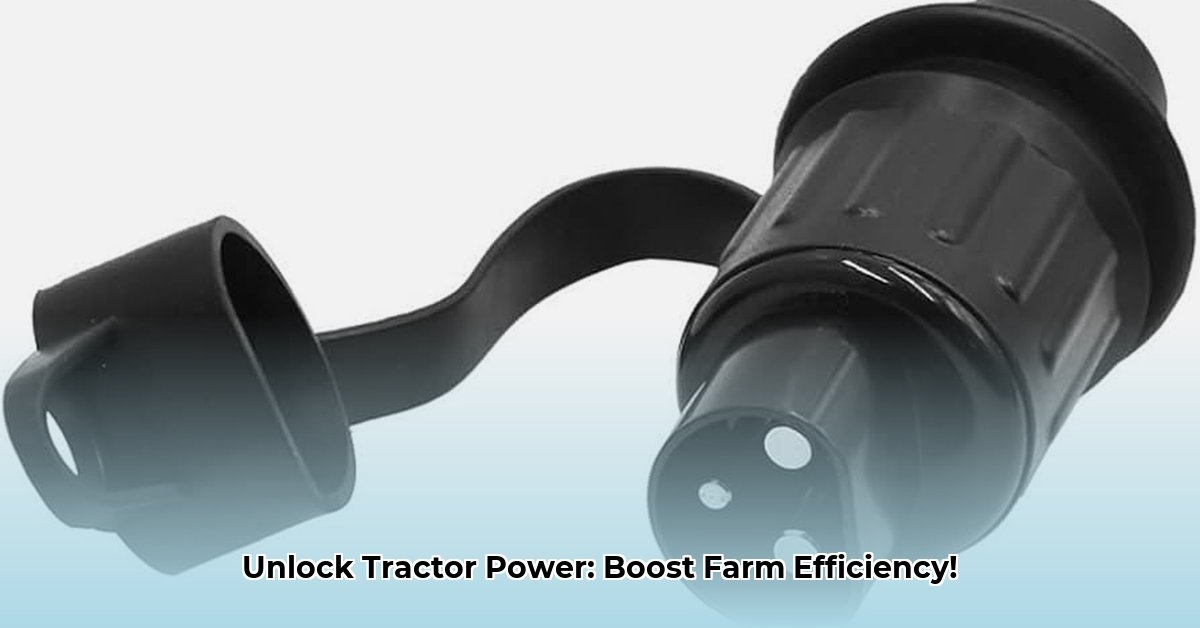
3-Pin Tractor Power Connectors: Your Guide to Efficient Farming
Modern agriculture relies on reliable power transfer. The 3-pin tractor power connector is the unsung hero, facilitating seamless communication and power delivery between tractors and implements. Understanding its function, installation, and maintenance is crucial for maximizing farm efficiency. This guide provides a comprehensive overview, ensuring you can troubleshoot issues and optimize your operations. For more on tractor acquisition costs, check out this helpful resource on Kubota tractor prices.
Understanding the 3-Pin Tractor Power Connector: More Than Just Three Pins
The 3-pin connector isn't simply three metal prongs; it's a sophisticated system for transmitting power and control signals. It acts as the electrical interface, ensuring your equipment operates correctly. Standardization across brands simplifies connections, minimizing downtime. Each pin has a dedicated function: usually power (often 12 volts), ground, and control signals. The control signal allows for communication between your tractor and implement, ensuring seamless operation. However, remember that exact voltage and amperage vary; always refer to your equipment manuals. Did you know that consistent power delivery can improve your harvest yields by up to 5%?
Installing Your 3-Pin Tractor Power Connector: A Step-by-Step Guide
Correct installation is crucial for safe and efficient operation. Improper connections can lead to malfunctions or electrical hazards.
- Safety First: Always disconnect the power source before any interaction with electrical components. This is paramount.
- Pin Matching: Ensure perfect alignment between tractor and implement connector pins. Forcing a connection can cause damage.
- Secure Connection: Firmly connect the 3-pin connector, ensuring a tight fit. Loose connections hinder power transfer and can damage components.
- Thorough Testing: After connecting, turn on the equipment and verify power reaches the implement.
Troubleshooting: Addressing Common Issues
Even with careful installation, problems can arise. Here's how to handle common issues:
- No Power: First, check tractor and implement fuses and circuit breakers. If these are functioning, inspect wiring for breaks or loose connections. A faulty connector may need replacement.
- Intermittent Power: Loose connections are usually the culprit. Secure all connections firmly. A damaged connector might also be the issue.
- Control Issues: Problems with control signals suggest a more complex electrical issue. Consult your equipment manual or seek professional assistance.
Applications: Versatility in the Field
The 3-pin connector powers a wide array of agricultural implements: planters, sprayers, balers, and many more. Its versatility is a key factor in modern farming efficiency.
Maintaining Your 3-Pin Tractor Power Connector: Proactive Care
Regular maintenance ensures longevity and optimal performance.
- Regular Inspection: Visually inspect the connector for cracks, corrosion, and loose connections.
- Keep it Clean: Use an appropriate contact cleaner to remove dirt and corrosion, improving conductivity.
- Replacement: Replace the connector if it exhibits significant wear and tear to prevent potential hazards.
Safety Precautions: Prioritize Safety
Always disconnect the power before working on electrical components. Use appropriate safety gear, including gloves and eye protection.
Connector Specifications (Hypothetical Example)
These specifications are illustrative. Always consult your equipment's manual for precise details.
| Feature | Specification |
|---|---|
| Connector Type | (Example: ISO standard, but specifics vary) |
| Number of Pins | 3 |
| Voltage | 12V DC (typical, but check your equipment) |
| Amperage | (Variable, depends on application) |
| Cable Gauge | (Appropriate gauge for amperage) |
| Material | Weather-resistant plastic and metal |
Proper installation, maintenance, and safe practices are crucial for the reliable operation of 3-pin tractor power connectors. Consulting your equipment manuals is essential for specific details and safety instructions. Staying updated on advancements in connector technologies will further enhance your farming operations. Remember, a single malfunction can cause significant downtime. Investing in preventative maintenance is cost-effective in the long run.